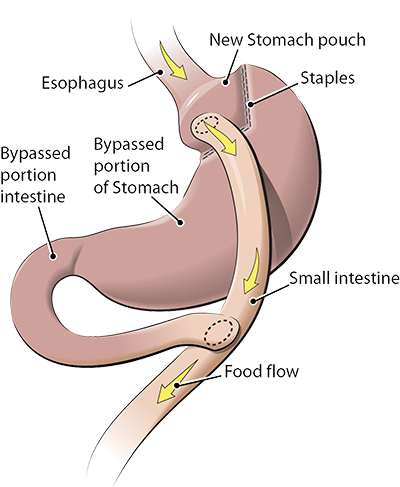Gastric Bypass Surgery
Roux-en-Y gastric bypass (RYGB) is a type of weight-loss surgery that reduces the size of your stomach to a small pouch – about the size of an egg. It does this by stapling off a section of it. This reduces the amount of food you can take in at meals.
The surgeon then attaches this pouch directly to the small intestine, bypassing most of the rest of the stomach and the upper part of the small intestine. This reduces the amount of fat and calories you absorb from the foods you are able to eat for even more weight loss.
The Gastric bypass is performed laparoscopic and Robotic. As a result of improved technology the risks of this surgery are very low.
In a gastric bypass procedure, staples are used to create a small pouch where food enters the stomach, disconnecting it from the rest of the stomach. The intestinal tract is then rearranged so that the small intestine is attached to the new pouch.
A segment of the small intestine that is left attached to the bottom of the stomach is then reattached to the segment previously attached to the pouch. This allows digestive juices and acids produced in the stomach, which remains healthy and active, to mix with food, allowing for a complete digestion process.
This impacts weight loss by creating both a restrictive and malabsorptive aspect. As food enters the stomach, it fills up more quickly because the volume of the stomach has been reduced and the patient feels full with less food. This is the restrictive component. Then, as food passes into the duodenum, it is carried directly to the lower part of the small intestine, bypassing much of the digestive process. This is the malabsorptive component. At this point, the two sections flow into a “common channel” where food and bile/digestive juices are combined.
The benefits of a duodenal switch procedure are numerous. First, it has a very high success rate, with low risk of regaining the weight. Because it is so successful, many conditions associated with obesity are minimized or eliminated, including type 2 diabetes and hypertension. Also, because the pyloric valve, which regulates the flow from the stomach to the duodenum, is preserved, patients don’t typically experience dumping syndrome, which happens when undigested food is passed through to the small intestine

